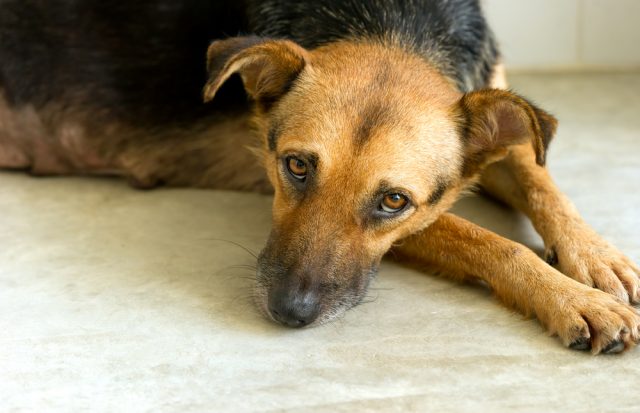By now you are probably aware that your dog has many of the same emotions as you do, including anxiety. But do you know what that anxiety looks like?
Amanda Cornell, CPDT-KA and owner of Accomplished Canines in Orange County, California, has years of experience working with anxious dogs. She provided the following signs to help you better understand when your dog is anxious.

Note: One thing to remember is that context is important when looking at your dog’s behavior. All of the signs listed below can be part of your dog’s normal, everyday behavior. However, if your dog is in a new environment and you see one or several of these behaviors happening repeatedly and in conjunction with each other, then your dog may be telling you that he’s anxious about the situation. If you think that might be the case, it’s time to seek out a certified dog trainer for help.
#1 – Won’t Settle
An anxious dog will pace, lie down, get back up, pace some more, and just never relax. If it’s something your dog has just started to do, think about what has changed that may be causing her anxiety. If she does it every day, then you need to work on reducing her overall anxiety.
#2 – Excessive Panting
Often called “stress panting,” dogs will pant when they are feeling anxious about something. If it is not excessively warm and your dog is heavily panting, he is most likely worried.
#3 – Hiding
An anxious dog will often look for a place to hide, where they can feel safer. Dogs that always hide are usually more fearful and anxious about life in general compared to other dogs.
Related: Best Thundershirts, Anti-Anxiety Vests & Coats for Dogs
#4 – Accidents
A dog that is fully housetrained, but suddenly starts having accidents in the house may be anxious. This could also be a health issue, however, so you should consult a vet and a dog trainer to rule all possibilities.
#5 – Whale Eye
Also called “half-moon eye,” whale eye is when the white of your dog’s eye is visible around the iris. Dogs will show the “whites of their eyes” when they are nervous, anxious or afraid.
#6 – Yawning
Like panting, yawning can be another sign your dog is anxious. Sure, a tired puppy yawns just like a human, but a dog yawning frequently in an obedience class or while pacing in your home may be anxious.
Related: The 10 Best Anti-Anxiety Dog Beds
#7 – Excessive Noise
Have a dog that is “always on alert”? Barking at seemingly nothing for no reason? Sure, your dog can hear better than you, but it can also be a sign they are anxious – every little noise is the “boogie man.” Whining can also be a sign of anxiety. Luckily, some positive training can fix both of these.
#8 – Tongue Flicks
Some dogs will lick their lips or rapidly flick out their tongue over their nose when they are nervous about something. If your dog is doing this (and there is no food around), then it might be his way of letting you know that he means no harm and he’d like to be left alone.
#9 – Full Body Shake
This looks similar to the shake that most dogs do after they get a bath. When dogs do this kind of shake away from water, they are literally trying to “shake” off the stress of the situation. “Phew, that was close!”
Related: 7 Best Sound Machines for Dogs with Anxiety
#10 – Slow Motion
While there are some dogs that can’t settle when they are nervous, there are others that go to the opposite extreme; their movement is slow and tense, and sometimes they refuse to move altogether. Your dog is not being stubborn – he’s telling you that something about the situation makes him feel anxious and unsafe.



Comments are closed.